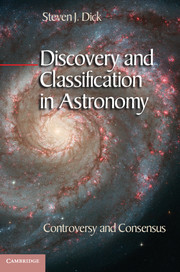Book contents
- Frontmatter
- Contents
- Preface
- Abbreviations
- Introduction The Natural History of the Heavens and the Natural History of Discovery
- Part I Entrée
- Part II Narratives of Discovery
- Part III Patterns of Discovery
- Part IV Drivers of Discovery
- Part V The Synthesis of Discovery
- Appendix 1 Astronomy’s Three Kingdoms
- Appendix 2 Astronomical Discoveries and Their Extended Structure
- Notes
- Select Bibliographical Essay
- Glossary of Concepts Related to Discovery
- Index
Appendix 1 - Astronomy’s Three Kingdoms
Published online by Cambridge University Press: 05 August 2013
- Frontmatter
- Contents
- Preface
- Abbreviations
- Introduction The Natural History of the Heavens and the Natural History of Discovery
- Part I Entrée
- Part II Narratives of Discovery
- Part III Patterns of Discovery
- Part IV Drivers of Discovery
- Part V The Synthesis of Discovery
- Appendix 1 Astronomy’s Three Kingdoms
- Appendix 2 Astronomical Discoveries and Their Extended Structure
- Notes
- Select Bibliographical Essay
- Glossary of Concepts Related to Discovery
- Index
Summary
As explained in Section 8.2, Appendix 1 constitutes an exercise in constructing a comprehensive classification system for astronomy. The “Three Kingdom” system begins with the three Kingdoms of planets, stars, and galaxies – the three canonical divisions adopted in textbooks for almost a century, since it became clear that galaxies were indeed a separate “realm of the nebulae,” as Hubble put it. For each Kingdom six astronomical Families are then delineated, based on the object’s origin (Proto-), location (Circum- and Inter-), subsidiary status (Sub-), and tendency to form systems (Systems), in addition to the “Central” Family (planet, star, or galaxy) with respect to which the other Families are defined. These considerations give rise to astronomy’s eighteen Families, and the symmetry of the six Families of each Kingdom reflects their physical basis in gravity’s action in all three Kingdoms. The system then distinguishes eighty-two classes of objects, a large subset of which are the subject of this volume.
Like biology, the Three Kingdom (3K) system is hierarchical, extending from Kingdom to Family to Class, with the possible extension to further categories lower in the hierarchy such as Type and Subtype. As in biological classification it occasionally adds an intermediate Subfamily level wherever useful. With the benefit of hindsight (and with utility in mind), the system incorporates some classes as they have historically been defined, and adds others as they might be defined in a coherent and consistent system. The criterion adopted for class status is, wherever possible, the physical nature of the object, rather than orbital, dynamical, temperature, morphological, spectral, or any other characteristics. Some of the principles of classification are discussed in Section 8.2.
- Type
- Chapter
- Information
- Discovery and Classification in AstronomyControversy and Consensus, pp. 343 - 346Publisher: Cambridge University PressPrint publication year: 2013



